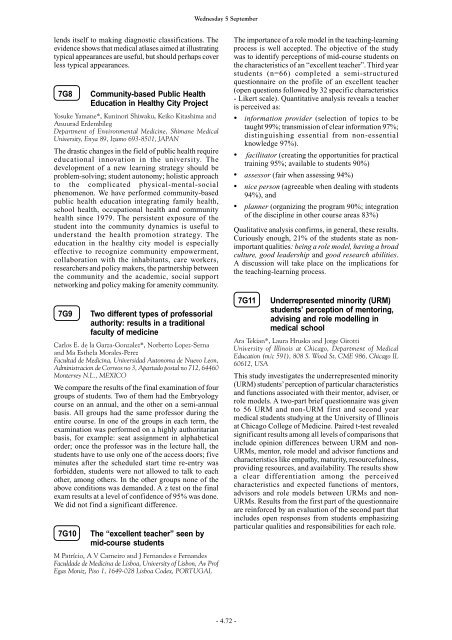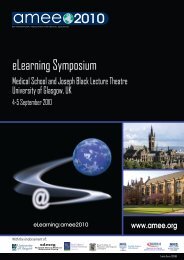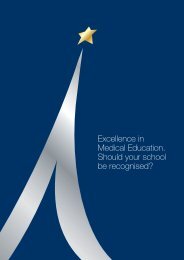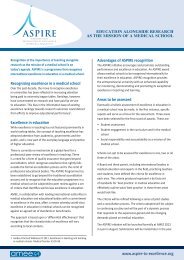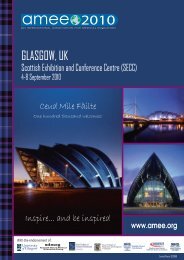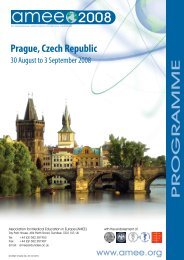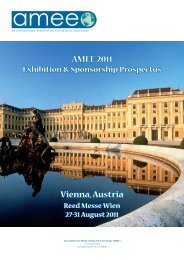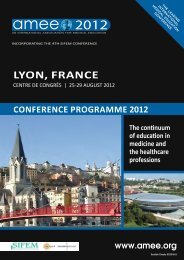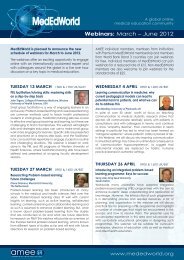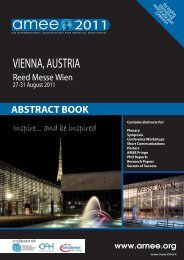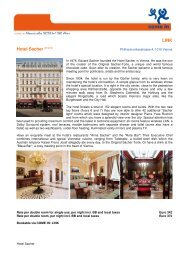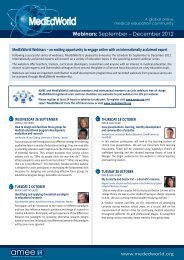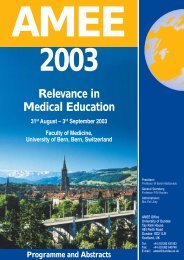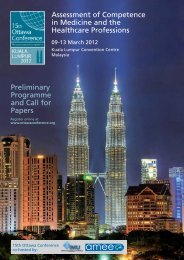AMEE Berlin 2002 Programme
AMEE Berlin 2002 Programme
AMEE Berlin 2002 Programme
Create successful ePaper yourself
Turn your PDF publications into a flip-book with our unique Google optimized e-Paper software.
lends itself to making diagnostic classifications. The<br />
evidence shows that medical atlases aimed at illustrating<br />
typical appearances are useful, but should perhaps cover<br />
less typical appearances.<br />
7G8 Community-based Public Health<br />
Education in Healthy City Project<br />
Yosuke Yamane*, Kuninori Shiwaku, Keiko Kitashima and<br />
Anuurad Erdembileg<br />
Department of Environmental Medicine, Shimane Medical<br />
University, Enya 89, Izumo 693-8501, JAPAN<br />
The drastic changes in the field of public health require<br />
educational innovation in the university. The<br />
development of a new learning strategy should be<br />
problem-solving; student autonomy; holistic approach<br />
to the complicated physical-mental-social<br />
phenomenon. We have performed community-based<br />
public health education integrating family health,<br />
school health, occupational health and community<br />
health since 1979. The persistent exposure of the<br />
student into the community dynamics is useful to<br />
understand the health promotion strategy. The<br />
education in the healthy city model is especially<br />
effective to recognize community empowerment,<br />
collaboration with the inhabitants, care workers,<br />
researchers and policy makers, the partnership between<br />
the community and the academic, social support<br />
networking and policy making for amenity community.<br />
7G9 Two different types of professorial<br />
authority: results in a traditional<br />
faculty of medicine<br />
Carlos E. de la Garza-Gonzalez*, Norberto Lopez-Serna<br />
and Ma Esthela Morales-Perez<br />
Facultad de Medicina, Universidad Autonoma de Nuevo Leon,<br />
Administracion de Correos no 3, Apartado postal no 712, 64460<br />
Monterrey N.L., MEXICO<br />
We compare the results of the final examination of four<br />
groups of students. Two of them had the Embryology<br />
course on an annual, and the other on a semi-annual<br />
basis. All groups had the same professor during the<br />
entire course. In one of the groups in each term, the<br />
examination was performed on a highly authoritarian<br />
basis, for example: seat assignment in alphabetical<br />
order; once the professor was in the lecture hall, the<br />
students have to use only one of the access doors; five<br />
minutes after the scheduled start time re-entry was<br />
forbidden, students were not allowed to talk to each<br />
other, among others. In the other groups none of the<br />
above conditions was demanded. A z test on the final<br />
exam results at a level of confidence of 95% was done.<br />
We did not find a significant difference.<br />
7G10 The “excellent teacher” seen by<br />
mid-course students<br />
M Patrício, A V Carneiro and J Fernandes e Fernandes<br />
Faculdade de Medicina de Lisboa, University of Lisbon, Av Prof<br />
Egas Moniz, Piso 1, 1649-028 Lisboa Codex, PORTUGAL<br />
Wednesday 5 September<br />
- 4.72 -<br />
The importance of a role model in the teaching-learning<br />
process is well accepted. The objective of the study<br />
was to identify perceptions of mid-course students on<br />
the characteristics of an “excellent teacher”. Third year<br />
students (n=66) completed a semi-structured<br />
questionnaire on the profile of an excellent teacher<br />
(open questions followed by 32 specific characteristics<br />
- Likert scale). Quantitative analysis reveals a teacher<br />
is perceived as:<br />
• information provider (selection of topics to be<br />
taught 99%; transmission of clear information 97%;<br />
distinguishing essential from non-essential<br />
knowledge 97%).<br />
• facilitator (creating the opportunities for practical<br />
training 95%; available to students 90%)<br />
• assessor (fair when assessing 94%)<br />
• nice person (agreeable when dealing with students<br />
94%), and<br />
• planner (organizing the program 90%; integration<br />
of the discipline in other course areas 83%)<br />
Qualitative analysis confirms, in general, these results.<br />
Curiously enough, 21% of the students state as nonimportant<br />
qualities: being a role model, having a broad<br />
culture, good leadership and good research abilities.<br />
A discussion will take place on the implications for<br />
the teaching-learning process.<br />
7G11 Underrepresented minority (URM)<br />
students’ perception of mentoring,<br />
advising and role modelling in<br />
medical school<br />
Ara Tekian*, Laura Hruska and Jorge Girotti<br />
University of Illinois at Chicago, Department of Medical<br />
Education (m/c 591), 808 S. Wood St, CME 986, Chicago IL<br />
60612, USA<br />
This study investigates the underrepresented minority<br />
(URM) students’ perception of particular characteristics<br />
and functions associated with their mentor, adviser, or<br />
role models. A two-part brief questionnaire was given<br />
to 56 URM and non-URM first and second year<br />
medical students studying at the University of Illinois<br />
at Chicago College of Medicine. Paired t-test revealed<br />
significant results among all levels of comparisons that<br />
include opinion differences between URM and non-<br />
URMs, mentor, role model and advisor functions and<br />
characteristics like empathy, maturity, resourcefulness,<br />
providing resources, and availability. The results show<br />
a clear differentiation among the perceived<br />
characteristics and expected functions of mentors,<br />
advisors and role models between URMs and non-<br />
URMs. Results from the first part of the questionnaire<br />
are reinforced by an evaluation of the second part that<br />
includes open responses from students emphasizing<br />
particular qualities and responsibilities for each role.


